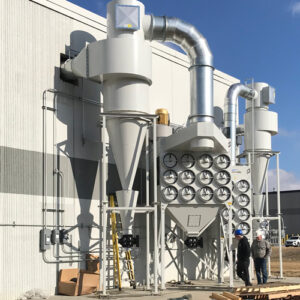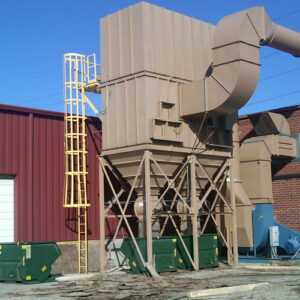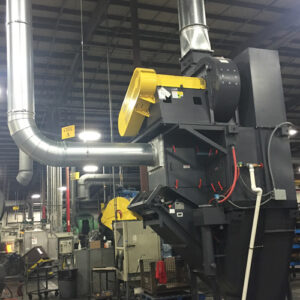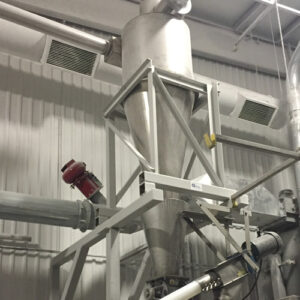Dust Collection
Industrial dust collection can be accomplished with several types of collectors. Understanding the application and process will help narrow down the best solution. There are several options and configurations involved in the design of a system. Options can include explosion equipment, rotary air locks, drum kits or super sacks (bulk bags), summer/winter dampers, HEPA after filters and many others.

Cartridge Collectors
Cartridge collectors have multiple pleated cartridges that include a compressed air cleaning systems to extend the life of the filters. Dust will collect in a drawer or hopper to be disposed of. These units can range from a single cartridge to multiple banks of cartridges depending on the CFM required and the type of materials being collected.
- Portable units. As indicated, normally includes casters and quick disconnect electrical an compressed air for portability.
- Ambient collection units. Used when source capture is not a feasible option typically hung from the ceiling, collects dirty ambient air pulls through cartridges and discharges clean air back into the plant.
- Custom designed systems. These systems can be many variations. From 500 CFM units mounted close to pick up points to 100,000 CFM plus systems with PLC controls and monitoring of system efficiencies.
- Typical applications. Sanding, grinding, Blasting, Chemical Processing, Ceramics, plastics, food processing, pharmaceuticals, mining, wood working, etc.

Bag Houses
Bag Houses used different types of fabric filter technology. Typically used when dust particle sizes are larger and amount of loading is extreme. Benefits include longer bag filter life.
Due to the larger loading, many times a secondary system will be incorporated to transfer the collected materials to a dumpster, baler or semi-trailer. Many units will incorporate compressed air for bag cleaning but there are cases where rotating reverse air flow or bag “shaker” systems are still used.
- Typical applications. Wood working, grain, metal chips, etc.

Wet Collectors
Wet collectors are used when the materials have certain characteristics that make a more traditional collector not feasible. Examples would be materials that are highly explosive and therefore, very costly to protect with traditional explosion prevention and materials that are sticky for example that will blank off a traditional style filter.Due to the larger loading, many times a secondary system will be incorporated to transfer the collected materials to a dumpster, baler or semi-trailer. Many units will incorporate compressed air for bag cleaning but there are cases where rotating reverse air flow or bag “shaker” systems are still used.
- Recirculating wet collectors. Recirculating wet collectors are normally used for materials that are highly explosive. The dirty air is pushed through a tank where the dust is captured and deposited into a recirculation tank. The materials will settle to the bottom of the tank to be manually cleaned out by hand, with a sludge pump or a drag conveyor and hopper. Typical applications would be for aluminum or titanium grinding, sanding and pharmaceuticals.
- Continuous wet collectors. A more economical option is a unit designed to use low flow of continuous water to flush materials off the separating impeller and directly down a drain. These units work best for sticky materials that dissolve in water such as food dusts or liquids, coal and chemical.

Industrial Cyclones
Industrial Cyclones generate centrifugal force through cyclonic air movement as the primary method to capture, recover or remove large and high-volume dust from industrial applications. Industrial Cyclones are also utilized when there is very high dust loading.
Because the efficiencies are lower than a cartridge or bag house, many times they are used as a pre-separator for a bag house or cartridge collector.
- Typical applications. Saw dust, metal chips, plastic chips, paper, corrugated board, cardboard, etc.